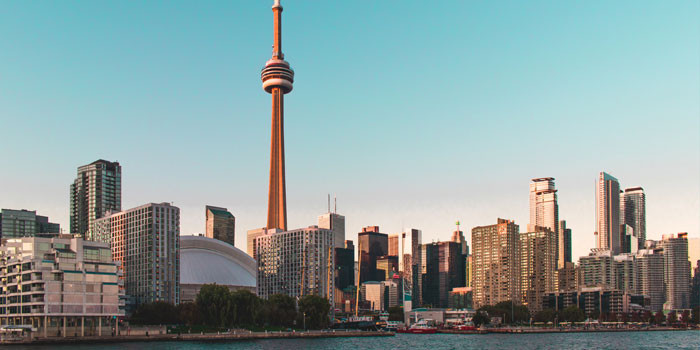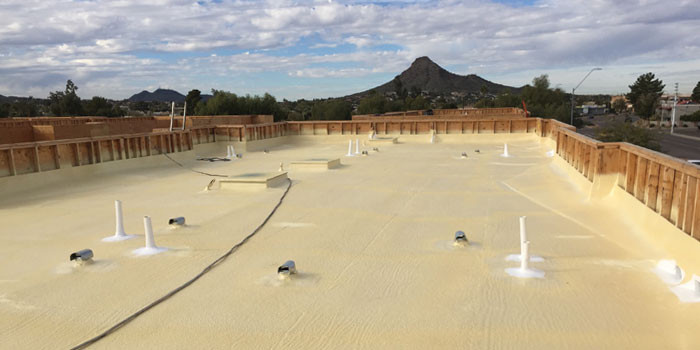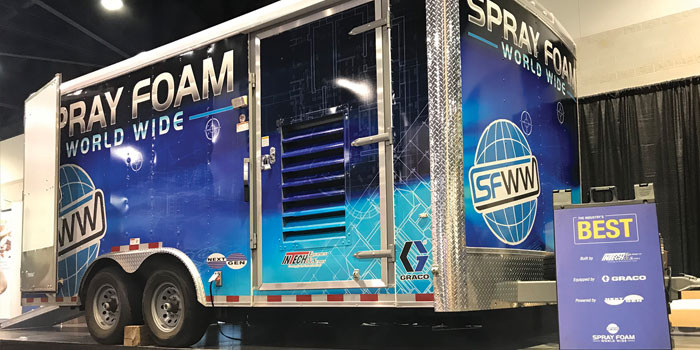Surviving the Fires of Northern California
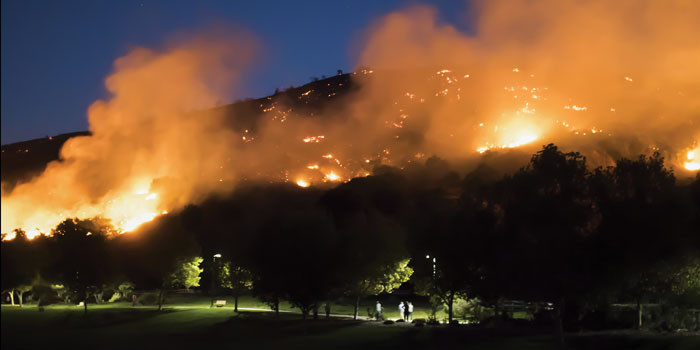

SPRING 2019 – The Northern California wildfires of October 2017, also referred to as the “Wine Country Fires” or the “Firestorm Fires”, were some of the deadliest fires the United States has ever experienced. A total of 250 wildfires raged across the northern part of California, burning a mammoth 245,000 acres of land. The extreme weather conditions meant that the deadly combination of parched land, fire and wind with gusts up to 70 mph, would help spread the fires rapidly. The governor at the time, Jerry Brown, declared a state of emergency in Napa, Sonoma, Yuba, Mendocino, Lake, Butte, Nevada, and Orange counties.
Wedge Roofing, based out of the San Francisco Bay area, have been roofing contractors for 43 years with a reputation for integrity, excellent work, and reliability. Spray Foam Magazine spoke with Gary Harvey, the general manager at Wedge Roofing, about the devastating effect of the fires and how their company is helping clients rebuild in the aftermath.
“The sky blackened very quickly,” Harvey recalls the evening the fires appeared on the horizon. “It was about 30 miles northeast of us. Then the wind shifted quickly and started blowing it straight down our valley.”
The initial concern for Harvey and his team were the roads that had either closed or had limited access for emergency services personnel only. It was in the middle of the night when the fire roared through the Coffey Park area in Santa Rosa, which is roughly 60 miles from Harvey and his team. Many of Harvey’s staff live just north of Coffey Park, so they were unable to get through the fire line to get to work. They were also reluctant to leave their homes, concerned they may not be able to return. They tried to protect their structures the best they could in case the wind changed direction and the fire headed towards them.
“The depletion of our workforce was a week-long event, but thankfully nobody lost their homes,” Harvey recalls. “My family and I are very active in the community, and we knew of 40 homes that were destroyed and the families displaced.” These fires ended up destroying 8,400 homes with the death toll rising to 44. “Just before the fires ignited in the area, we were roofing a very nice home set in the grounds of a picturesque vineyard,” Harvey continues. “Before the client was able to pay the final invoice, their home was destroyed. They are currently rebuilding and we will be back to re-spray the roof mid-summer.”
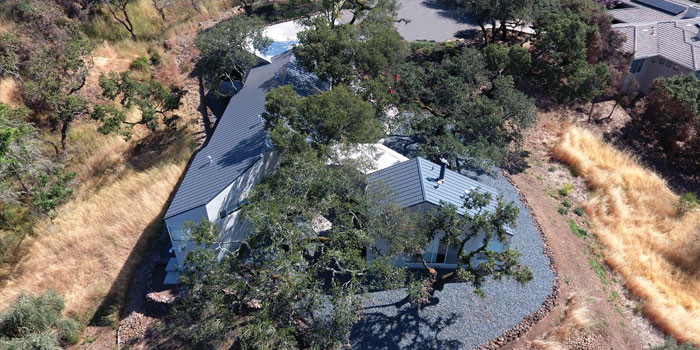
Wedge Roofing has been working diligently on projects recently which have included some spray foam and metal roofing projects designed to be specifically more fire resilient.
Not only did the fire destroy lives, homes, and businesses, but due to the depletion of foliage and landscaping, there were mudslides and land movement to contend with as well. Once the fires died and prior to the structures being rebuilt, there was a great deal of site-work and land recovery. The removal of toxic chemicals and harmful components, which were left in the soil as a result of the fire, had to be disposed of.
After the devastation, a majority of the homeowners stayed in the area, with many still in the process of rebuilding. Harvey states, “I have, on average, two rebuilds a month. Most people stayed in the area, unlike the fires two hours north of us, which decimated people’s workplace and employment. The fires that struck here mainly went through the residential area. People have stayed and occupied hotels, trailers, and friend’s homes because their place of employment and their children’s schools were still intact. We were very lucky in that respect.”
There are so many stories of tragedy, destruction, and heartache, which were left smoldering in the embers of these fierce fires. Harvey pauses and recalls, “One of our good friends is a local sheriff. He received a call about 2:30 a.m. and was out in the field evacuating the general public when he realized his home was directly in the path of a fire. He was able to call his home and luckily got his family out in time. For me personally, that was a touching story because he was protecting the public while his own family was in jeopardy. They escaped the house with only the clothes on their backs. Some of the people in that area literally had less than fifteen minutes to get out of their homes before they burned to the ground.”
Concern grew for Wedge Roofing, situated in a small valley, as the roaring fires ripped through the hills and ridges to the north and northeast of the company’s building. Harvey explains, “We have live-streaming cameras, which we use to monitor our jobs. We set three of these up on top of our office roof to aim at the surrounding hills. This enabled us to watch the facility day and night, and provided a little extra time to give evacuation notices. We made the feed accessible to our employees and all the people in town so they could use our live stream to monitor the valley. The cameras were not focused on specifics—nobody’s homes or business—it just gave us the ability to know if it was dropping down into our valley.”
Harvey has definitely noticed a rise in construction after the fires and with over four decades in the roofing business, Wedge Roofing is in a position where it can choose which projects they take on. He emphasizes, “We have been selective on the clients we have accepted for the fire rebuild and we have recently completed some very stunning spray foam and metal roofing projects to be specifically more fire resilient.”
Harvey and his team helped collect clothing, food, and water to deliver to the local shelters. In addition to this, they worked alongside the local coastguards. “We utilized our larger trucks to deliver material where needed. It really was a true community, in the sense of helping each other out,” he emotionally explains.
“When the fire was only three miles away, the wind pattern shifted and our skies were not as dark. It could have been a lot worse for us in terms of casualties, and we really did have a lucky escape,” Harvey elaborates. “People in our valley may have lost homes, but we were lucky to save most businesses and our lives. Even though many of us still have go-bags (bags with emergency supplies) packed for such instances, we are strong and we are rebuilding.”
Helping Clients Rebuild
(Due to the emotional sensitivity of these selected rebuilds, Spray Foam Magazine has decided not to publish the names of the properties or families involved in specific rebuilds. All sources have been verified).
Wedge Roofing has numerous clients that are starting to rebuild the properties that were badly damaged or destroyed during the California fires of 2017. Here is what one of those clients remembers the night the fires arrived on their doorstep.
Spray Foam Magazine: What happened the day the fires reached you?
“The night of the fires, we were awakened by the bullhorn of a sheriff’s car driving down the street, warning us of the impending fire and informing us we had 15 minutes to evacuate. It’s a short amount of time in the middle of the night, from the time you wake up, process what you just heard, gather your family and pets and get out. 15 minutes is nothing—and we literally escaped with the pajamas on our back, our children, our pets, and one vehicle. It wasn’t until several days later that a friend of ours, who is a sheriff patrolling the burned area, notified us that our house had been destroyed.”
SFM: Are you doing anything different with this rebuild, compared to the original?
“Our new home is following every recommendation and guideline to offer us the most resilient structure against what we look at as ‘the next fire event.’ It’s not a question of if, but when. We have utilized everything from noncombustible siding, double tempered high temperature glass windows, a metal roof with fire retardant materials below that, and spray foam roofing over double the recommended material for fireproofing.”
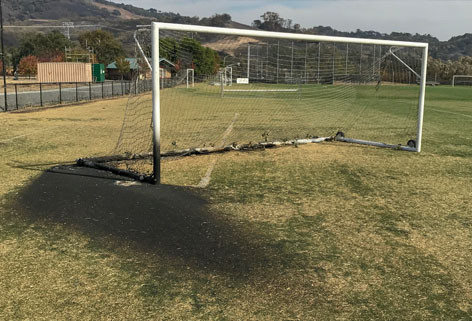
The fires not only destroyed homes, but also schools and sports fields, such as this soccer field that was not completely destroyed, but contaminated by the resulting toxins migrating to the soil.
SFM: How have you and your family been affected emotionally?
“Our friends are scattered throughout the county, with some even leaving the state after the fires. The normality that my children felt has been shattered. The school they attended, Cardinal Newman, is now a pile of ashes. The fields of the local soccer club our family participates in, SRU Santa Rosa United, were scorched. They were not completely destroyed, but they were contaminated by the resulting toxins migrating to the soil. When your home, your school, your social life, and your sports are disrupted, you can’t imagine the anguish. There were multiple fundraising events, some specifically for us, which were a great comfort for the daily necessities.”
SFM: How is the rebuild project progressing?
“After the tragedy of losing everything, next you have to battle for the insurance money that hopefully will set you on the path of rebuilding. We were one of the lucky ones, who received most of the money from our insurance carrier. We are a relatively small community without the resources to rebuild thousands of structures. Finding a general contractor to build our home was easier for us because we were one of the first families in the position to rebuild. However, the delays had only just begun. First the toxic grounds had to be cleaned up by the government prior to any rebuilding. Then there was no infrastructure. Water, power and sewer also needed to be repaired prior to us breaking ground. Fast forward to a year and a half later, and we are a couple of months short of moving in.” »
Wedge Roofing is still working on numerous rebuilds, all of which are situated within Santa Rosa and Sonoma—both within Sonoma County, California. The rebuild projects were specified via the Wildland-Urban Interface (WUI) building codes and general building codes. Highlighting two particular rebuild jobs, Harvey states, “One of the two jobs was a fire restoration and the second was a pre-emptive, roof-related move and measure to guard against future wildfires.” Harvey also pointed out the benefits of spray polyurethane foam (SPF) insulation for these jobs. “Beyond the superior insulation factor and racking and sheer capabilities, the best life cycle analysis was the ability to be installed quickly and with multiple layers of fire suppression.”
On one structure, the existing roof was removed and two layers of half-inch thick sheet rock were installed for Class A-rated system. On the second structure, the existing Class A-fire rated system was re-fastened and prepared to receive the new spray foam. Code requirements for the past six to eight years in this particular geographical area have recognized and adapted to the potential danger of a wildfire and its urban interfacing. As a result of this, both of these structures had the ventilation aspects removed from the side of the buildings and the soffits. Any and all attic ventilation was performed via rooftop intake and exhaust to minimize/eliminate the potential for the flame’s heat and embers being drawn into the attic through a hyperactive natural convective pattern when exposed to the heat of wildfire.
In keeping with Wedge Roofing’s personal protective equipment policy (PPE), and in accordance with CAL-OSHA, good standards and principles, all applicators were outfitted head-to-toe with chemical resistant suits, gloves and full-face masks–respirators with filters. All personnel involved with the spray foam and coating applications outside the confines of the CAL-OSHA perimeter warning lines were outfitted with a harness/lanyard combination set connected to a leading edge with 30-foot self retractable lifeline, all securely anchored to the substrate by reusable anchors.
These rebuilds took Wedge Roofing five to seven working days to complete with their roofing systems. The roofs incorporate both the steel and foam roofing with five crew members on the spray foam and four on the standing seam metal.
Harvey states, “One of the rebuilds was a contemporary modern design, with our standing seam metal and spray foam on the structure. For me, the ‘aha’ moment at the completion of the job was that we were able to maintain, and arguably even enhance, the aesthetics of this building, while providing the utmost in protection in the event of a future wildfire.”
Spray Foam Magazine asked Gary Harvey if these devastating fires had tempted his company to change their location? He replied, “The only thing that matches the fires resilience is our wildfire urban interface roof design and our resolute determination to stand with our community in rebuilding after these catastrophic fires. We hope we are offering some comfort to our clients, with them knowing we will be here for them.”
Disqus website name not provided.




